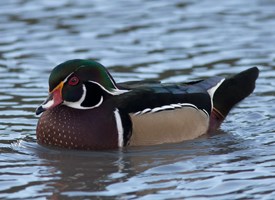
And now for of the classiest looking birds you are ever likely to find, the wood duck. They are some of my very favorite water fowl, and why? Well for one their Latin name, Aix sponsa, literally means “waterfowl in a wedding dress.” And for good reason! Male wood ducks are immediately recognizable by their classy drooping green crests with stylish white stripes. While, females are not quite as colorful, they are still sport an elegant brown crescent and white tear-drop markings around the eye.
Wood ducks are the second most popular game duck in America (the first being, of course, the Mallard). But they haven’t always been so abundant. In fact, in the early 1900s, wood sucks were so popular for their beautiful feathers and for their taste, that they had been driven virtually extinct. However, due to the Migratory Bird Treaty Act, passed by congress in 1918, and the tireless efforts of conversationalists, wood ducks have made a huge comeback, and are now of very little concern. *sniff* I love a good species success story.
One of the most intriguing aspects of wood duck recovery is their tie to the American beaver. Beavers go a long ways to create the ideal habitat for wood ducks, and the spread of beavers throughout wood duck range has been one of the many steps in helping the ducks rebound. This however, is not to downgrade any of the steps that conversationalists did on their own. Protecting habitat and building and placing nest boxes have been some of the most important steps to helping the wood duck recover.
What else has helped them recover? Why their own reproductive abilities of course! Almost all ducks will reproduce only once per year, but not this one. In fact, the Wood duck is the only North American duck to reproduce twice in a year, greatly helping to increase their numbers. Also unlike other ducks, wood ducks have sharp claws on their feet; this allows them to perch in trees and tree hollows, their preferred nesting areas. When there are not enough adequate tree cavities, wood ducks will use the large amount of nest boxes that have been provided by volunteers and conversationalists. These nest boxes, however, have caused a new wood duck phenomenon to come to light. Female wood ducks housed in nest boxes are known to carry their eggs over and place them in a neighbor’s nest while the neighbor is away. This phenomenon, known as brood parasitism (brood=children) allows mothers to pass along their genes without actually spending energy in raising the child, and is not uncommon among birds. However, what makes this so intriguing is that this was not noticed in wood ducks until they began using the nest boxes. Why only then? Well we don’t really know, but the most likely answer is that this happens in nature, but only when females are nesting close together. So when people began building lots of nest boxes close together, this brood parasitism immediately began to stand out.
Spring is just around the corner! So if you see any cute and fuzzy spring animals (or any kind of animal really, since they’re all amazing) that you want to know about, please leave the request in the comments.
Here are my sources:
The source for the image above was: http://www.allaboutbirds.org/guide/Wood_Duck/lifehistory/ac
it was taken by Brian L. Sullivan http://www.briansullivanphotography.com/
No comments:
Post a Comment